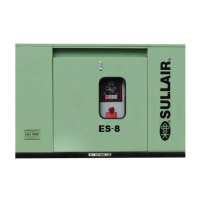Section 9
TROUBLESHOOTING
34
9.2 TROUBLESHOOTING (CONTINUED)
SYMPTOM PROBABLE CAUSE REMEDY
COMPRESSOR DOES NOT Air Demand Exceeds Supply Check air service lines for open
BUILD FULL DISCHARGE valves or leaks.
PRESSURE
Inlet Air Filter Clogged Check for maintenance message
on Supervisor display. Inspect and/or
change element.
Inlet Valve Not Fully Open Check actuation and butterfly disc
position.
Pressure Sensor and/or Connections Check connections from trans-
at Fault ducer. If adequate, replace trans-
ducer.
LINE PRESSURE RISES ABOVE Pressure Sensor P2 at Fault Check connections from trans-
UNLOAD SETTING ducer. If adequate, replace
transducer.
Unloading Device (i.e., Blowdown Check operation of unloading device.
Valve, Sullicon Actuator, Optional
Spiral Valve) Failed to Operate
LINE PRESSURE RISES ABOVE Solenoid Valve Failed Check operation of solenoid
UNLOAD SETTING to Operate valve.
Control Air Signal Leaks Check tubework feeding control
signal for leaks.
Control Air Signal Filter Clogged Service filter assembly.
EXCESSIVE FLUID CONSUMPTION Clogged Return Line Strainer or Clean strainer - screen and o-ring
Orifice replacement kit available. Clean
orifice.
Damaged or Improperly Gasketed Inspect separator elements and
Separator Elements gaskets. Replace if damaged.
Fluid System Leaks Check tube/pipework for leaks.
Fluid Level Too High Drain excess fluid.
Excessive Fluid Foaming Drain and change fluid.
NOTE ON TRANSDUCERS:
Whenever a sensor is suspected of fault, the recom-
mended cause of action is to measure the signal
(pressure, temperature, etc.) with an alternate cali-
brated instrument and compare readings. If read-
ings conflict, the electrical and/or tubing connec-
tions should be inspected, and if no faults are evi-
dent, then replace the sensor and re-evaluate
against the calibrated instrument.
9.3 CALIBRATION
The Supervisor II has software calibration of the
pressure and temperature probes. This calibration
affects the offset but not the slope of the pressure
and temperature calculations. Because of this, the
most accurate method is to heat or pressurize the
transducer to its operating value. If this is too diffi-
cult, room temperature/open atmosphere calibra-
tion is adequate. Calibration may only be done while
machine is stopped and unarmed.
To enter calibration mode, you must press the fol-
lowing keys in sequence while in the default status
display mode: “
”, “ ”, “ ”,PRG.Once in
calibration mode, you will see a screen like the fol-
lowing:
CAL P1
970
In the above example, “0” refers to the amount of ad-
justment (in psi or °F, “97” refers to the current value
of P1).
To make adjustments, Press the “
”(UPAR-
ROW) key to increase the value, press the “
”
(DOWN ARROW / LAMP TEST) key to decrease
the value. The number on the left will increase or de-
crease always showing the total amount of adjust-
ment. Maximum adjustment is + 7.
The DSP key exits, wiping out changes to the cur-
rent item, while saving changes to any previous
items. The PRG key saves the current item and ad-
vances to the next. All temperatures and pressures
may be calibrated individually.

